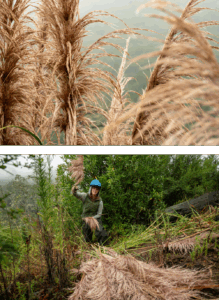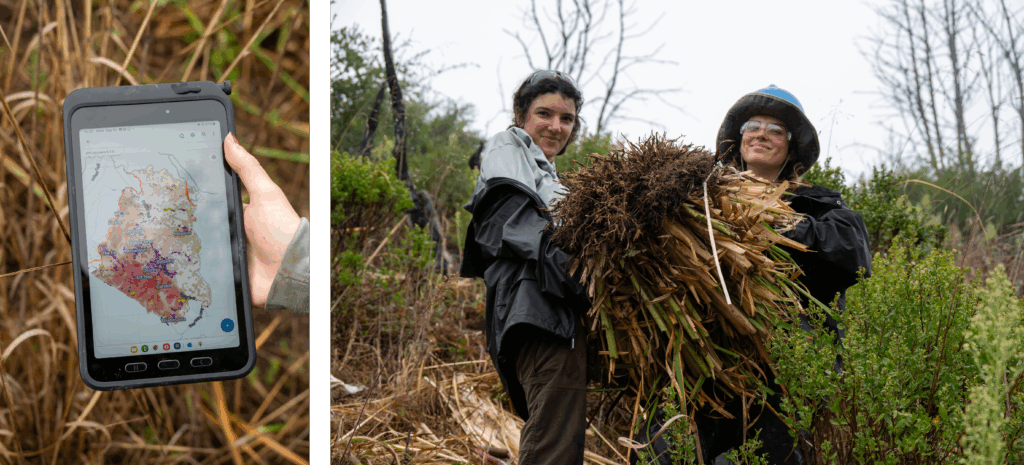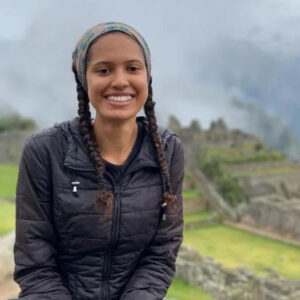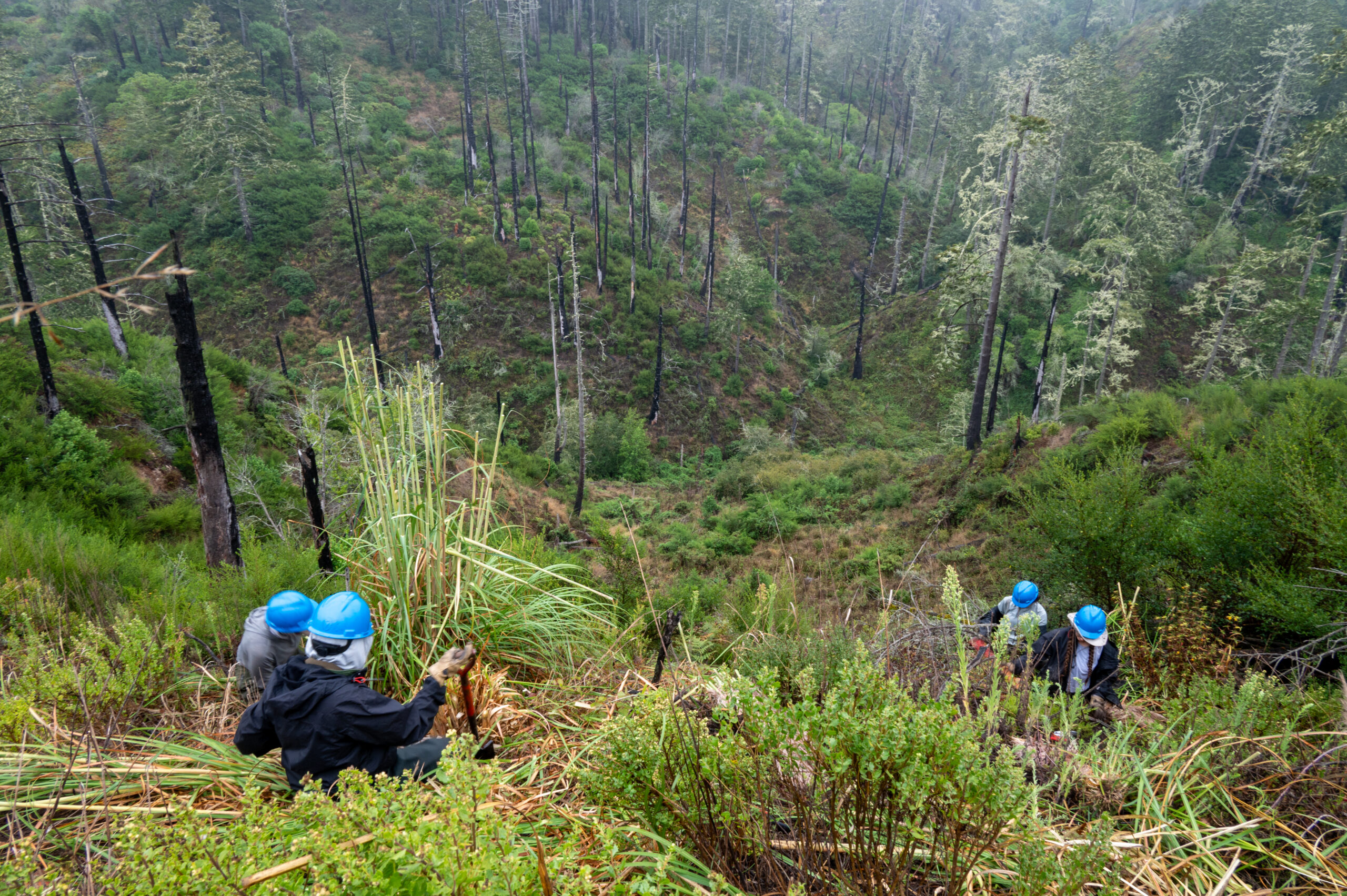Healing the Scar: How an All-Women Team is Restoring the Woodward Fire Burn Area
November 6, 2025__|__Avani Skye Fachon, PRNSA Multimedia Storytelling Coordinator
Deep in Point Reyes National Seashore’s Philip Burton Wilderness, a team of six women push through a dense thicket of 15-foot tall Ceanothus, their blue hardhats and safety goggles shielding them from a mass of green stems. It’s nearly impossible for the crew to see a few feet ahead or overhead; from a bird’s eye view, they would be concealed within the foliage, along with the creatures who inhabit this wild brush. Curious gazes alight on the team through tight spaces between the snarls—there, the big round stare of a black-tailed deer; below, the beady almond peepers of a dusky-footed woodrat; above, the yellow-rimmed eyes of a Wilson’s warbler. This land is alive, and it is thriving.
The 2025 Point Reyes Vegetation Crew—managed by NPS biologists, led in the field by PRNSA Biological Science Technician Miriam Golding, and supported this year by seasonal NPS Technicians Carly Courtwright, Lindsey Gaul, Ava Meena, Anna McGuffie, and Claire Zechiel—is on a mission: to support the healing of the Woodward Fire burn scar.

The Biodiverse Burn Mosaic
The 2020 Woodward Fire—sparked during a massive nighttime lightning storm—burned nearly 5,000 acres of the Seashore’s wilderness, heavily altering the landscape. This fire, however, stood apart from the many 2020 California fires which burned with extreme intensity. While stands of Douglas fir trees and tracts of coastal scrub were torched, many other areas were left only mildly singed—and there was no significant threat to human safety or structures. 67% of the fire area was mapped as “unburned or low severity,” and 25% was classified as “moderate severity.” In these locations, the blaze traveled through ground cover (ex. huckleberries and ferns) but left the secondary (ex. oaks and bay trees) and/or upper canopy (ex. Douglas fir trees) intact. Only 8% of the burn scar was found to be “high severity”—areas where all layers of the forest were consumed. These heavily scorched areas converge with the zones which barely burned in a patchwork over the landscape.

“This [variation in burn severity] means that you’ll get a greater diversity of fire effects,” says PRNSA Biological Science Technician Miriam Golding. “Some of the areas that burned severely have all these native fire-followers coming up like Ceanothus and bishop pine, [species that play a critical role in post-fire regeneration], and then you’ve got other areas which barely burned at all and have the older surviving plants. It’s really cool, it creates a nice mosaic of diversity.”
A fine-scale mosaic of varying burn severity is considered ideal for post-fire regeneration, and necessary for the regrowth of a diverse and intricate ecosystem. Prior to European colonization, Native peoples regularly used fire to regenerate the Point Reyes peninsula, a supplement to open areas created by other “natural” disturbances—such as lightning which caused the Woodward Fire. They burned coarse-grained patches—such as whole meadows—and fine-grained patches—such as small openings in woodlands. Just as colors overlap and mix to create new ones, different habitats overlap to form ecotones—the transitional area between two plant communities. In turn, this opens the possibility for new communities and the highest possible ecosystem biodiversity to thrive. The Philip Burton Wilderness has burned infrequently since the suppression of Indigenous stewardship practices; the Woodward Fire presented a rare opportunity to observe how this landscape can benefit from a mixed-severity fire and a mosaic of ecotones.
| Science Corner: Flourishing with Fire Unburned or less severely burned areas serve as “wildfire refugia,” in which fire-sensitive flora and fauna can persist during and after a burn event. More of these refugia scattered throughout the burn zone allow for easier dispersal of seeds from live flora, which leads to a greater diversity of species that are able to regenerate in the area. Microbial diversity in the refugia re-colonize burned soils, bolstering the soil health for plants to repopulate the area. In turn, burned soils are rich in vital nutrients from dead plants and animals, and the removal of dead organic material clears space, creating more opportunity for sunlight, water, and real estate which stimulates new growth. Furthermore, some plants require intense heat to trigger germination; bishop pines’ mature seeds, for instance, are retained inside of cones until heat from a fires—or an extremely hot day—melts the tight resin bonds. |
Though difficult to imagine from deep inside the thicket, the dense Ceanothus brush wasn’t here five years ago. “The tunnel we walked through wouldn’t have existed without fire,” laughs Golding, reminiscing on the team’s experiences wading through this species’ dense brush. “Ceanothus seeds only sprout when it gets hot enough.”
The mosaic of habitat types with potential to flourish after the Woodward Fire is incredible—but without stewardship, the area is at risk.
The All-Women Dream Team

The vegetation team forges ahead through the freshly regrown Ceanothus brush to visit a patch of jubata grass (Cortaderia jubata), which has taken firm root in one of the more severely scorched areas of the Woodward Fire burn zone.
The newly bare soil opens the opportunity for highly competitive species—such as the jubata grass—to colonize before native plants. Native to the northern Andes and introduced to the United States through the horticultural trade, this long-lived perennial produces large, feathery plumes which can release up to 120,000 seeds into the environment, easily overtaking the landscape. As more of these giants establish in the burn scar, space, minerals, and water become more limited, crowding out native plants and preventing them from establishing themselves.
The burn scar is still in the early stages of regeneration, and the team is here at a critical time. “They [jubata grasses] were here before the fire, and they will be here after the fire; we cannot get every single one,” says Golding. “But if we can treat these patches and prevent them from establishing when the soil is bare, then native plants can regrow, and it will be much harder for the species to take over in the same way.”
Throughout the summer, the team worked through the strenuous process of removing the giant jubata grass; most established individuals are taller than a person and have massive, fibrous roots which are firmly embedded in the soil. The crew works in pairs, cutting off the plants’ feathery plumes and digging up their roots, and finally, burying or packing out the plumes to prevent them from germinating. Their work goes beyond jubata grass—they’ve removed other invasives such as Maltese starthistle (Centaurea melitensis) and pennyroyal (Mentha pulegium) from the burn zone, and conduct regular surveys of trails, heavily burned off-trail areas, dozerlines (areas of high operational activity during the fire, including containment lines created by firefighters to stop the spread), to ensure that new invasives aren’t moving in. The team’s work also extends beyond the burn zone—they’ve worked on projects from taking censuses of the federally endangered Tidestrom’s lupine (and fending off deer mice to protect their seeds), to kayaking through the Giacomini Wetlands to monitor invasive pepperweed, to spending hours organizing monitoring data.
From April through September of this year, the team surveyed 2,829 acres of the burn zone and removed thousands of jubata grasses and other invasive species from the area. The crew’s efforts are laborious and challenging—both mentally and physically—and they have worked through it with determination, day by day. Their map of work locations offers a glimpse at the many arduous, funny, awe-inspiring adventures that they’ve experienced together; site names range from “thistlevania” and “baby’s first” to “elk nap” and “cursed”…the latter hinting at what must have been a particularly challenging day in the field. Through their collective experiences, they’ve developed a strong sense of camaraderie, especially as an all-women crew—uncommon in this field:
“It has been so empowering to work on this team of women. Even on hard days, I knew I could count on their constant laughter and encouragement to raise my spirits,” says vegetation crew member Lindsey Gaul.


“Through the Burn Area Restoration program…we are continuing the work of past crews and people,” says vegetation crew member Anna McGuffie. The Woodward Fire is just part of the history of the park, along with the Mount Vision Fire, so it’s cool to see how the ecological processes of fire, renewal, and regeneration have come along. We get to see that on an intimate level.”
This season may be the last for the Woodward Fire Burn Area Rehabilitation Program—the federal government typically only funds five years of post-fire restoration, considering that an ample length of time to support burn scars in establishing a healthy regrowth process. This and the past four vegetation crews’ dedication during these critical early years of regeneration have created a healthy foundation for the land, work that will positively impact the course of the ecosystem’s growth far into the future.
“There are large parts of this fire scar that look amazing,” says Golding. “It’s so cool to come back every year and know what the landscape looked like in 2021, 2022, 2023…and to see native plant communities come back, knowing we prevented something bad from happening there.”
 Avani Fachon (she/her) is a multimedia storyteller inspired by stories of interconnection in the natural world—the magic which happens when dust from the Sahara flutters across oceans to nourish far-away trees and when a hummingbird’s beak evolves just-right to sip nectar from a flower. She holds a B.A. in Ecology and Evolutionary Biology with a minor in Media Production from University of Colorado Boulder, where she was involved with several art-science projects.
Avani Fachon (she/her) is a multimedia storyteller inspired by stories of interconnection in the natural world—the magic which happens when dust from the Sahara flutters across oceans to nourish far-away trees and when a hummingbird’s beak evolves just-right to sip nectar from a flower. She holds a B.A. in Ecology and Evolutionary Biology with a minor in Media Production from University of Colorado Boulder, where she was involved with several art-science projects.

